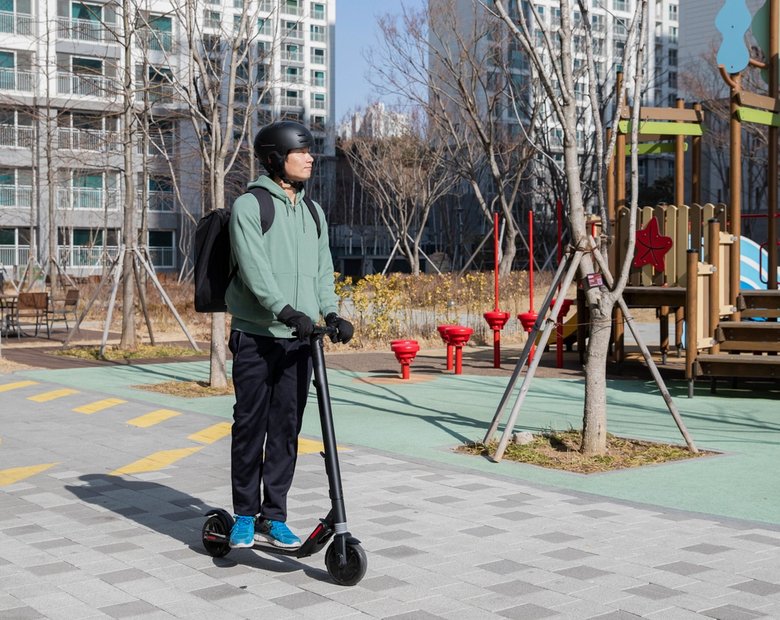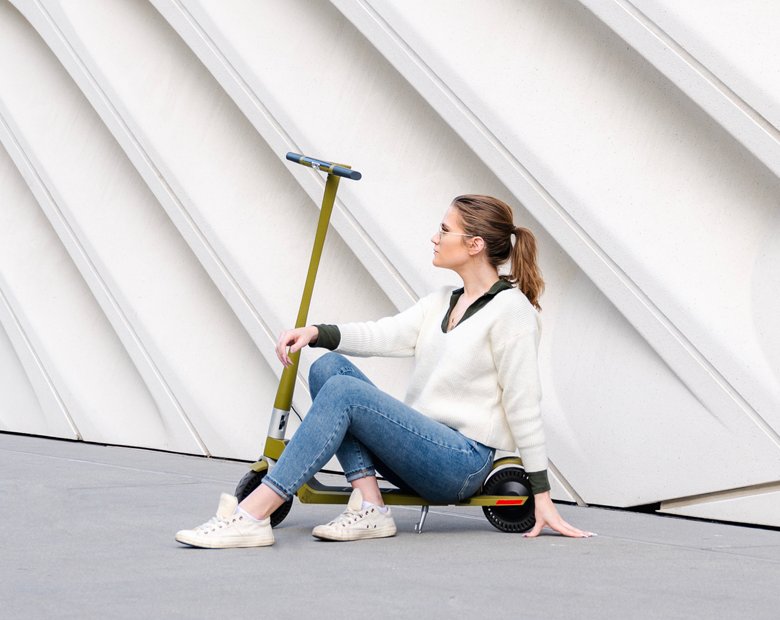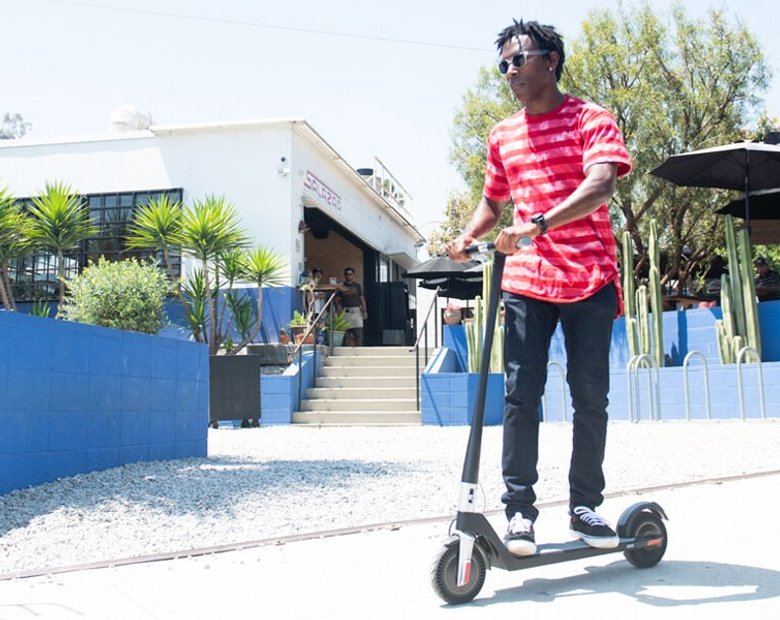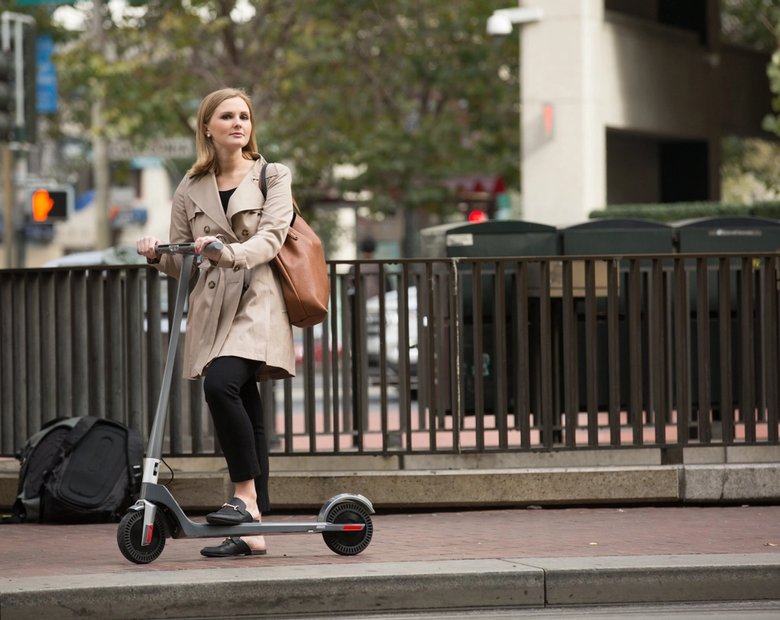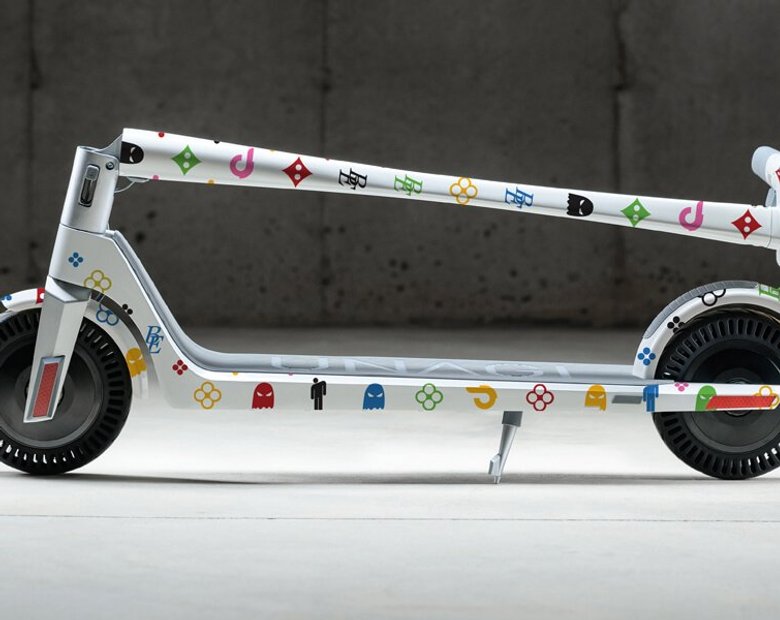Picture this: you're on your Unagi electric scooter, the city sprawls out behind you, and ahead lies the challenge – a hill, steep and daunting, daring you to climb. This isn't just another ride; it's an adventure, a battle against gravity itself.
That's because riding uphill on an electric scooter can turn the simplest of journeys into an epic quest. Here, every degree of incline adds to the challenge, and resistance and gravity conspire to test your mettle and your scooter's prowess.
So, whether you've taken out an Unagi Subscription, or you're just curious how to climb steep hills on an escooter, with our top tips and techniques for tackling steep hills, you'll power up them like a pro.
The challenge of riding uphill
Riding an electric scooter uphill is not as simple as cruising on flat ground. You've heard of Newton's third law - the one that says for every action there is an equal and opposite reaction. Well, trying to ride an e scooter uphill is that law in action.
Riding your electric scooter uphill is like pushing against an invisible force, striving to maintain speed and vigor as the slope tries to pull you back. Climbing hills on a scooter is more than a test of technology; it's a delicate balancing act of balance and control, calling for strategy, for an understanding of how to distribute your weight, how to adjust your stance, and when to push forward or ease off the throttle.
Let's explore these a little more in-depth.
Factors affecting climbing ability

Photo Credits: Nischal Malla | Unsplash
Not every scooter is equipped with natural hill climbing abilities. Several factors influence an electric scooter's performance on inclines, including motor wattage, battery capacity, tire size, weight limit, and overall maintenance.
Motor wattage and power
When it comes to getting up those hills, the wattage of your scooter's motor is pretty much the MVP, directly impacting your scooter's climbing ability. Higher wattage means your scooter packs more punch – it's got the power and torque to smoothly take on steeper hills without breaking a sweat. Quite simply: more power equals better climbing.
Battery capacity and range
The battery capacity determines your scooter's range and its ability to maintain power while climbing hills. The bigger the battery, the longer it can keep going, especially when you're heading uphill. A larger battery doesn't just mean you can go farther on a single charge; it also means your scooter can push harder for longer, making those uphill climbs a breeze.
Tire size and traction
Bigger and wider tires on your scooter are like hiking boots for the urban climb - they give you that grip and stability you need when the road starts to rise. And just like boots with deep treads are great for rough trails, scooter tires with deeper treads or special patterns grab onto the road better, making sure you stay upright and in control, no matter the terrain.
Weight limit and load capacity
The weight limit is a scooter's carrying capacity - it's how much it can handle before things start to get tough. Pushing past this limit makes climbing those hills harder on the scooter, putting extra strain on the motor and dialing down its performance. Picking a scooter that suits your weight, along with whatever else you're carrying, means you'll get the best out of it on those uphill challenges.
Proper maintenance and condition
Just like you'd tune up a bike before a big ride, regular checks and maintenance on your scooter make all the difference. This means keeping an eye on tire pressure, making sure the brakes are tight and right, and the motor's running smoothly. A clean and well-oiled machine cuts down on friction, making it easier for your scooter to take on those climbs.
Importance of riding techniques
Mastering the art of riding uphill allows for smoother and more efficient rides, no matter what scooter you're cruising on. Getting the hang of things like how to position your body, balance your weight, and pace your speed can make you feel like a scooter whisperer.
It's about being in sync with your ride, knowing when to push it and when to let it coast, all to keep the strain off the motor and save your battery from an early retirement. Plus, mastering these moves isn't just good for your scooter's health; it's a game-changer for safety, too.
Keeping a slight lean forward and distributing your weight evenly means you're less likely to take a tumble when the road gets steep. And let's not forget, life's not about the destination, it's about the journey; so putting the time into mastering the following techniques means you get to enjoy the climb as much as the view from the top.
Technique one: Adopt a better stance for better hill climbing

Even the most powerful electric scooter will still need you to put in a little effort to help it climb hills. Some top tips for body positioning on uphill rides include:
- Lean into it: Imagine you're leaning in for a secret – that's how you should lean into those hills. A slight tilt forward shifts your center of gravity, putting more pressure on your front wheel, and giving it more traction and the grip it needs to keep you moving without slipping back. Just don't get too nosy and lean too much, or you might throw off your balance.
- Bend those knees: Keeping your knees slightly bent serves two purposes. Firstly, slightly bent knees help soak up the bumps and jolts of uneven paths, making your ride smoother. Plus, it provides flexibility and improves your ability to maneuver the scooter.
- Stand firm: Your feet are your foundation, so plant them firmly on the deck, shoulder-width apart. This stance is your stability secret, keeping you upright and in control, no matter how steep the hill gets. Distribute your weight evenly between both feet, allowing for better stability and stability during the ascent. Try not to lift your feet too high off the footboard, as it may affect your control over the scooter.
- Chill out: Riding uphill doesn't mean tensing up. Keep your back straight, shoulders down, and arms relaxed but ready. This chill posture isn't just about looking cool; it's about maintaining control and minimizing strain on your upper body so you can easily adapt to whatever the road throws at you.
- Eyes on the road: Just like a scout on the lookout, keep your eyes peeled for what's ahead, anticipating any issues. Spotting obstacles and changes in the road early lets you adjust your stance and strategy on the fly, ensuring your ascent is as smooth as your scooter's electric hum.
Technique two: Maintain speed and momentum
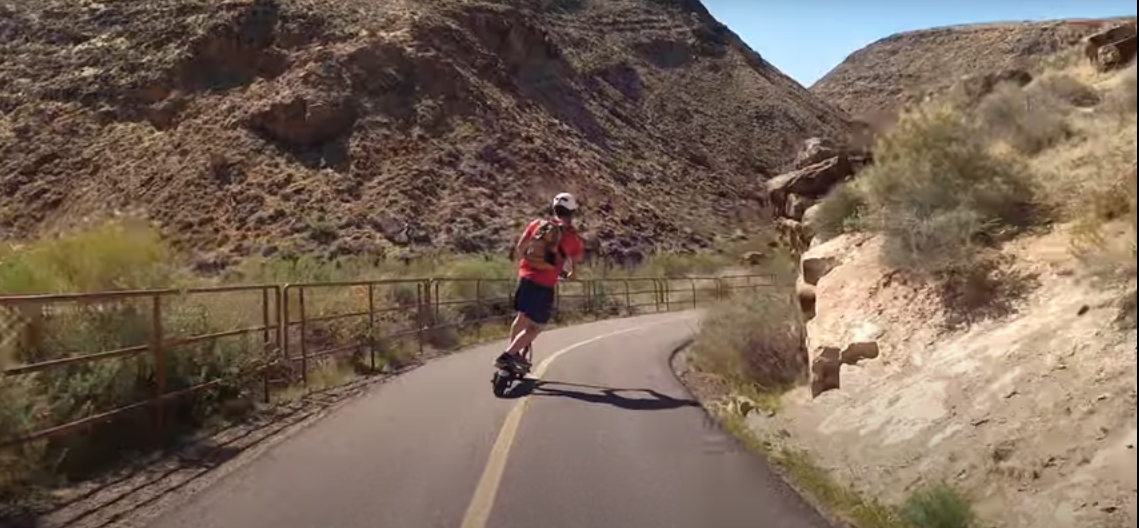
Keeping your speed steady and your momentum going while scooting uphill is key to conquering the incline efficiently, reducing strain on the motor, conserving battery power, and ensuring a smoother uphill ride.
- Avoid sudden acceleration or deceleration: Abrupt acceleration or deceleration can put excessive strain on the scooter's motor and drain the battery faster. Instead, start picking up speed gently before reaching the hill to build momentum. This way, you keep a steady pace that won’t leave you or your scooter gasping for breath halfway up.
- Match your speed to the incline: Adjust your speed according to the steepness of the uphill slope. Steeper slopes might call for dialing it back a bit to keep everything under control, while you can let loose on gentler inclines. It’s all about finding that sweet spot where you’re moving just right without overdoing it.
- Utilize the scooter’s kinetic energy: Use the momentum you’ve built on the flat stretches to help push you up the hill. It’s like getting a running start before a leap—it can make the climb feel a bit less like a mountain. Minimize braking and try to coast when you can to keep that momentum without burning extra power.
- Anticipate the incline: Look at the hill ahead of time and plan your attack. Anticipate the incline and adjust your speed accordingly. By preparing in advance, you can ensure a smoother transition and maintain a consistent pace. A bit of foresight can help you navigate the uphill section more efficiently and maintain your speed and momentum.
- Monitor battery power: Keep an eye on your battery level as you go. Climbing hills is thirsty work for your scooter, consuming more battery power due to increased motor usage. And you don’t want to run dry at the wrong moment. If you see the battery level dropping, ease off the throttle and save some juice to make sure you have sufficient power to complete your journey.
Technique three: Ride hills in the right settings

You wouldn’t set off to climb a mountain in flip-flops, right? Similarly, selecting the appropriate gear is key for tackling uphill sections effectively.
Most electric scooters come with multiple speed settings or gears that allow you to adjust the performance and power output. By choosing the right gear for uphill climbs, you can increase torque and power, helping your scooter to handle steeper inclines with ease. Here’s the lowdown on shifting gears to conquer those urban peaks.
- Increase torque and power: Switching to a lower gear is your scooter’s secret weapon against gravity. It increases the torque output of the motor, that all-important force that keeps your scooter chugging along, even when the hill’s trying to pull you back down. A lower gear means more power for the climb, helping you push forward without losing momentum.
- Enhance performance and efficiency: Choosing the right gear keeps the motor operating within its optimal power range. That's because electric scooters are designed to deliver maximum performance at specific speed ranges. When you’re going uphill, dropping down a gear lets the motor operate at a higher RPM (rotations per minute), where it can deliver more power efficiently.
- Prevent strain on the motor: Making electric scooters go uphill in too high a gear can put excessive strain on the motor. This strain not only affects the motor's performance but also increases energy consumption, leading to faster battery drain. Dropping to a lower gear spreads the effort more evenly, avoiding unnecessary strain on the motor and keeping your battery from draining too quickly.
Technique four: Balance and stability

Mastering the uphill climb on your electric scooter is a bit like learning to surf. It's all about finding that sweet spot of balance and stability, even when the road throws you curveballs.
- Relax and center your upper body: Picture yourself as a chilled surfer riding a wave. Keep your upper body loose and centered over your scooter. Tensing up is a no-go as it can affect your balance and control; it's all about letting your arms and shoulders go with the flow. This laid-back vibe helps you adapt to the ups and downs of the road, keeping you stable and in control.
- Avoid sudden movements: Sharp turns and sudden leans? Not on this ride. Keeping it smooth is the secret to maintaining your balance, especially when the hill gets real. Think graceful, smooth, and controlled actions help maintain balance and stability. Ease into the throttle and brakes gradually applying pressure as needed.
- Shift your weight: It's all about the lean. Imagine you're leaning into a gust of wind—shift your weight slightly uphill to counteract the slope. This doesn't mean throwing yourself sideways; it's more about a subtle tilt to keep you steady and prevent any dramatic scooter tilts.
- Absorb bumps and vibrations: The road's not always smooth, but your arms can be your personal shock absorbers to dampen any impacts. Keep them slightly bent and relaxed, ready to soak up any jolts and help stabilize the scooter.
- Maintain a forward focus: Keep your eyes on the prize, not on your feet. Looking ahead at your destination helps you see what's coming, letting you adjust your stance in advance. It's about being one step ahead of the road, ready to tackle whatever it throws your way with grace.
- Practice and build confidence: Like any good skill, conquering hills takes a bit of practice. Start with the easy slopes and work your way up as you get more comfortable. It's all about building that confidence and balance, one hill at a time.
Technique five: Braking and descending

What goes up, must come down. And riding your electric scooter downhill is all about mastering the art of regenerative braking. It's crucial for a ride that's both safe and smooth. Here's how to nail the descent every time.
- Gradual braking: Think of braking like easing into a hot bath. You want to do it slowly to keep things under control. Slamming on the brakes can throw everything off balance, leading to potential slips or skids. A gentle squeeze on the brakes allows you to maintain stability and control as you head downhill.
- Avoid excessive braking: While you want to maintain control over your speed when flying downhill, constantly hitting the brakes hard can wear them out and even lead to overheating, reducing their effectiveness. It's like tapping the brake pedal in a car non-stop; it's not good for the system. Instead, aim for a light, intermittent touch to keep your speed in check without putting too much heat on your brakes.
- Maintain a balanced posture: As you move downhill, leaning back a bit helps counteract the forward pull of gravity. It's about redistributing your weight to stay upright and avoid tipping over the handlebars. This balanced stance is key for a stable descent.
- Keep a safe distance: Just like driving, you want to keep enough space between you and anything ahead of you. This buffer zone gives you time to react if something unexpected pops up. And with speed picking up on the descent, a little extra room goes a long way for safety.
- Monitor speed: Keep an eye on how fast you're going. If you start to feel like you're zipping down too quickly, it's time to gently apply those brakes. Staying aware of your speed helps you adjust on the fly, ensuring a descent that's controlled and comfortable.
Conclusion

Ready to transform your uphill battles into smooth rides? With Unagi's All-Access Scooter Subscription, you're not just getting the best electric scooter; you're unlocking a seamless, powerful, and stylish uphill experience.
Whether you're eyeing the sleek Model One Voyager with its 1000W peak power and up to 25 miles range or the head-turning Model One Classic, Unagi has you covered.
Our subscription model means you can enjoy premium commuting without the premium price tag, complete with the flexibility to upgrade, zero commitment, and peace of mind with comprehensive maintenance and theft insurance.
Don't let steep inclines hold you back. Subscribe now, elevate your ride, and join the Unagi revolution. Your city, your hills, your terms. Learn more about Unagi All-Access and start your adventure today.
Frequently Asked Questions
Can any electric scooter handle steep inclines?
While most electric scooters can handle gentle slopes, not all are suitable for steep inclines. Look for models with higher power and torque ratings for tackling challenging uphill terrains. Unagi scooters, particularly the Model One Voyager, are designed with power and performance in mind, featuring a peak power of 1000W. This makes them more than capable of handling steep inclines, setting them apart from many other electric scooters on the market.
How do I maintain the battery life while riding uphill?
To conserve battery life, maintain a steady speed, avoid unnecessary braking or acceleration, and utilize the scooter's kinetic energy by coasting whenever possible. If you're riding an Unagi scooter, most of the hard work is done for you - Unagi's efficient design and power management system help ensure that you can enjoy extended riding times without unnecessary battery drain.
What safety gear is essential for riding uphill?
For uphill rides, essential safety gear includes a helmet to protect your head in case of falls or collisions, knee and elbow pads for additional protection, and sturdy footwear to ensure a good grip on the scooter's deck.
Are there any weight restrictions for riding uphill on an electric scooter?
Weight restrictions can vary depending on the scooter model. Unagi scooters, for example, are built to accommodate riders efficiently without compromising performance, even on inclines. It's important to check the manufacturer's guidelines and recommendations for safe riding on inclines.












